Often lost amid the debates about Pakistan’s security situation are the problems its rural economy faces. Agriculture is the foundation of Pakistan’s economy—it accounts for over a third of export earnings—and that sector is struggling. The annual agricultural growth rate averaged just 2.8 percent from 2010 to 2014, a significant drop from the growth rates experienced during the previous two decades. While agriculture growth rates are often volatile year-on-year because of weather and market fluctuations, public policy and investment can have profound effects on reducing the impact of this volatility.
A forthcoming IFPRI book due out in January, Agriculture and the Rural Economy in Pakistan: Issues, Outlooks, and Policy Priorities, by researchers David J. Spielman, Sohail J. Malik, Paul Dorosh, and Nuzhat Ahmad, examines what can be done to revitalize that country’s agricultural sector and rural economy in light of recurring macroeconomic policy shifts and weather-related shocks.
Pakistan cannot achieve robust overall growth without a boost to its agricultural and rural productivity and incomes, the authors write. That will require intensive efforts to manage land, soil, water, and energy more sustainably. It will also require dramatic reforms to markets for seed, fertilizer, land, and commodities such as wheat, and policies to clarify land tenure issues, encourage rural enterprise development, and improve the status of rural women.
With growth comes the promise of reduced poverty, but growth alone will not be sufficient to eliminate poverty and its related problems in rural Pakistan. That will require dedicated attention to public services in the countryside—especially social safety nets and programs for health, education, community development, and women’s empowerment.
The book makes a set of specific recommendations on how rural Pakistan can achieve sustained growth and reduce poverty. They include:
- Adapt to climate change. Much of Pakistan is semi-arid, making the country particularly vulnerable to climate-related shocks. The book explores the impact of alternative policies and investments in water storage and distribution, including canal rehabilitation, maintenance, and drainage, to keep water flowing, protect against severe floods, and meet the country’s changing water and energy needs.
- Increase agricultural resilience. If Pakistan wants sustainable, consistent growth, it must fortify its agriculture sector against weather extremes including droughts, floods, heat, and cold, and against pests and diseases. This will require public investment and substantive policy reforms in agricultural research, extension, seed systems, and agricultural input markets to support farmers.
- Reallocate public funding. To fund such reforms, the authors recommend that the Pakistani government shift spending from the domestic procurement, storage, and distribution of wheat, which amounted to 24.84 billion Pakistan rupees (PKR), about $255 million, in 2012/13. Savings can also be found by reducing subsidies to the fertilizer industry, with that money redirected to research and extension efforts designed to improve soil and fertility management.
- Adapt to urbanization. The rapid growth of Pakistan’s urban areas means that demand for high-value perishable products such as fruits, vegetables, dairy, and meat is rising. Maximizing this important opportunity for rural growers, the authors say, will require major infrastructure investments including more stable electricity services, reliable transport networks and other building blocks of modern supply chains.
- Target poverty. Improving conditions for the rural poor will require major investments and policy reforms at the national and provincial levels, including expanded, well-targeted social safety nets; improved health and education service delivery; an expansion of hygiene and sanitation infrastructure in rural areas; and capacity strengthening for public service provision at the provincial and local levels.
- Empower women. Policy makers currently pay too little attention to the role of women in Pakistan’s rural society and economy, their inability to exit from low-productivity rural activities, and their disempowerment in economic and social aspects of day-to-day life, the authors say. Some existing social protection and microfinance programs are helping rural women, and these can be models for a much broader effort. With a stronger focus on better targeting, participation, and graduation, social protection programs and community-driven development programs can be central to Pakistan’s poverty reduction strategy.
Rural Pakistan, the authors say, is at a turning point. Its agricultural sector has enormous potential, and can make significant progress in building the national economy and toward eliminating poverty – but only if leaders and policy makers seize the opportunity to invest and reform.
John McQuaid is an IFPRI media consultant.







